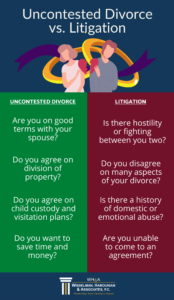Understanding the Divorce Process in New York
No one enters into a marriage believing that it won’t last forever. However, statistics estimate that around 40-50% of first-time marriages will end in divorce. The divorce rates for second and third marriages are even higher. Marriages don’t work out for a variety of reasons, but one thing that remains constant is the importance of knowing what to do next.
Understanding the divorce process can help eliminate some of the anxiety that many individuals feel when deciding that separating from their spouse is the best option for their family. In order to help you feel less stressed, our team at Wisselman, Harounian & Associates is here to break down the various steps involved in the New York divorce process.
How to File for Divorce
First, let’s start with what you need to know once you have decided to go through with a divorce. To file in New York, you must meet one of the following residency requirements:
- Either you or your spouse must have lived in New York for two consecutive years prior to divorcing
- Either you or your spouse has been living in New York for at least a year and you were married in New York or lived in the state as a couple
- Either you or your spouse has been living in New York for at least a year and the grounds for divorce occurred in New York
- Both spouses live in New York when the divorce is filed and the grounds for divorce occurred in New York
If you have satisfied the residency requirement, the next step is knowing whether you have grounds for a divorce, which are essentially circumstances under which a person will be granted a divorce by the court. The state of New York recognizes the following seven grounds for divorce:
- An irretrievable breakdown in the relationship for a period of at least 6 months. This is usually called a no-fault divorce.
- Inhumane or cruel treatment. It must be shown that one spouse has been in emotional or physical danger within the last five years and it is unsafe for them to remain in the marriage.
- Abandonment. To claim this as grounds for divorce, it must be shown one spouse abandoned the other for at least one year; for instance, this may be used if a spouse leaves the house with no communication or intention of returning home.
- Imprisonment. A spouse must have been in prison for a period of three years or more after the marriage began.
- Adultery. It must be shown one spouse committed adultery during the marriage.
- Separation agreement. Both spouses must have signed and filed a valid separation agreement and lived apart for at least a year.
- Judgment of separation. While not used very often, this may be used when the Supreme Court draws up a judgment of separation and the couple has lived apart for at least a year.
Our Long Island divorce attorneys can review your case for free to determine whether you have grounds for a divorce and craft a unique, personalized legal strategy for your situation.
Next comes the paperwork. New York courts require individuals beginning the divorce process to prepare, fill out, and file a relatively large number of forms. The actual forms that are necessary to fill out will depend on whether you and your spouse have children. Some courts allow you e-file online through the New York State NYSUCS – New York State Courts Electronic Filing. New York State Unified Court System
Ensuring that you have the right documents filled out correctly is crucial to moving forward with your divorce in a timely manner. Whether you are in Long Island or one of the five boroughs of New York, our legal team can help you file your needed paperwork to ensure there are no delays with the process.
Determining Which Divorce Is Right for You
Every couple’s situation is different. The good news is that there are various types of divorce processes that you can explore in order to find which one is best for you. Typically, divorce falls into two categories: uncontested divorce and contested divorce.
Uncontested Divorce
An uncontested divorce is a simplified process that generally stays out of court. It requires the full cooperation of both parties and the filing of documents with the court by a legal professional.
As both spouses are fully cooperating in an uncontested divorce, the process can be relatively amicable, simple, and straightforward. Rather than deal with the court process, which can take many months or even years, the couple can use separate family law attorneys or a divorce mediator to prepare the required paperwork and complete the process in an amicable fashion. Since there are no court procedures, an uncontested divorce saves significant time and money compared to a contested divorce.
Mediation is often a beneficial process that can be used during an uncontested divorce. During this process, a qualified and certified mediator will work together with both parties involved to help them layout options and mutually agree on debated issues. It is important to note decisions made in divorce mediation are not concrete until the divorce agreement is finalized.

If you’re wondering whether you should explore this option further, here are some signs that an uncontested divorce may be the right choice for your unique situation:
- You are on good terms with your spouse.
- You agree on the division of property, including what is considered marital property and separate property.
- You agree on child custody, visitation plans, and support payments.
- You want to save time and money.
Wisselman, Harounian & Associates has successfully handled many mediation cases for our clients who are amenable to work out a settlement.
Contested Divorce
Ultimately, an uncontested divorce is not for every couple. Some are not able to overcome disagreements or meet in the middle during negotiations. If you serve divorce papers to your spouse and they disagree with anything in them, the divorce will become contested.
What this means is that the couple determines they aren’t on the same page concerning their divorce. As a result, the case will most likely go to court and issues will be settled through litigation. A judge will hear the attorneys of both parties present evidence and make decisions accordingly.
Here are some signs that your specific circumstances may be best suited for a contested divorce and going to court:
- There is hostility between you and your spouse.
- You both disagree on many aspects of your divorce, including child support, child custody, and asset division.
- There is a history of emotional or physical abuse within the marriage.
- You and your spouse are unable to come to any agreement.
Experienced Representation Is a Must
Divorce is nothing to be ashamed of. At Wisselman, Harounian & Associates, we are ready to assist you and your family through your most trying times and help you navigate any unexpected obstacles that may arise.
We understand that there is no one-size-fits-all solution when it comes to divorce. We strongly believe that whenever possible, settlement opportunities should be explored, but if an out-of-court settlement is not possible, our firm is prepared to zealously advocate for your rights to custody, support, and asset distribution.
Ready to take the next step towards a brighter future? Get in touch with our Long Island family law team at (516) 773-8300 today! We offer no-fee, no-obligation consultations and can work with your busy schedule to find a time convenient for you.



